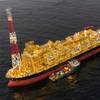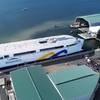Something Old, Something New ...
Dave Sintes of Sintes Fiberglass Designs has been tweaking his CADKEY-brand CAD-CAM software for over 10 years, customizing and augmenting the off-the-shelf 3-D program to produce scantlings, drawings, materials lists, and weight and balance calculations for his designs. When the boat's design is complete, the program produces computer-disk instructions to guide the yard's flat-bed router.
Even on Sintes' 700 mHz computer, the CADKEY program is fast and versatile. With a few mouse-clicks, Sintes can fine-tune a vessel's lines by altering its 3-D on-screen rendering. He can specify frame points, nest all frames and other plywood components onto 4 x 8-ft. sheets, and make full-size mylar prints for precision joining of frame components.
Sintes' designs are available as plans, frame kits, and completed boats. "I have three kinds of customers," he said. "Individuals wanting a certain type of boat will order the kit and build the boat himself, or he'll have us build it. Boatbuilders around the world order our frame kits to build boats for their customers. And many boat companies order our frames to build molds for their own production models."
Situated on the shore of Lake Pontchartrain, Sintes has long been known for his lake skiff designs, and has more recently been recognized for reconstructing a Higgins landing boat for the New Orleans D-Day Museum. His portfolio also includes many commercial and sportfishing designs. "The biggest boat I've built using C-Flex and computer-cut frames was an 85 ft. Chinese junk," Sintes said. "That was a big boat, but she came out well. She sailed out of here for a round-the-world trip."
A Sintes design starts with some general comments by the customer as to what he wants, including length, speed, mission, propulsion horsepower, capacities, and equipment. "A stick drawing is sometimes enough," Sintes laughed. He then shows the customer a previous design nearest to the customer's specifications. With 3-D rendering, Sintes can broaden, narrow, lengthen, or shorten the design; he can increase or decrease the flare of the bows, the height of the topsides, or the rake of the transom. "After two or three revisions," he said, "I can usually come up with a hull form the customer likes."
The program also computes weight-and-balance for the design, and provides a table of changes to the vessel's overall weight and trim with an alteration of any dimension. "I know from experience where I want the Center of Gravity to be," Sintes said, "but in the old days I never knew whether I'd hit it until the boat was built. Now I can locate it down to the millimeter before we cut one board."
The program also accounts for the weight of piping, machinery, accommodations equipment, and deck equipment in calculating the vessel's weight-and-balance. "If I design in a piping system with fifty pieces of pipe in it," Sintes said, "I draw the lines where I want the assembly to go and specify the type of pipe, for example, Schedule 40. The program automatically draws in the pipes with their full dimensions, calculates the total weight of all pieces and their total moment (their effect on the Center of Gravity), and draws the holes in the bulkheads, deck, or hull for the pipe to penetrate."
"All of my designs are meant to be built in C-Flex," Sintes said. "To my mind, no other material makes sense for a small-boat hull. In fact, we have become a C-Flex dealer so we can ship C-Flex supplies along with our frame kits." C-Flex is a patented hull material made of long resin rods imbedded in a matrix of fiberglass roving. Although more expensive than molded fiberglass construction, C-Flex offers compound curves without a mold.
Sintes doesn't design for steel due to weight and corrosion considerations, and avoids plywood due to its susceptibility to rot. And since neither material permits compound curves, vessels built of steel or plywood often suffer by comparison in performance, fuel consumption, and aesthetic appeal.
After the frames and other components have been laid out on the computer, sheets of .75-in. Chilean plywood are laid on the cutting table and the pieces are routed out. "There isn't much wood left after I've fit everything I can onto each sheet," Sintes laughed. "In fact, recently I've started sending out frame kits still attached to the original sheet, so the whole package is easier to handle with a forklift."
Previously, Sintes had cut the frames and banded them together, but now he leaves small "tabs" holding each piece in place in the sheet. After delivery, the builder cuts the tabs off with a saw and removes the pieces. The cost of transporting the left-over pieces is far outweighed, in Sintes' opinion, by the increased ease of handling and by reduced transportation damage.
"My router cuts in a label for each piece of each frame," Sintes said. "Further, I notch out each mating edge with a matching protrusion in the other edge, so all parts fit together like jigsaw-puzzle pieces." The frames-built like bulkheads, with each station fully assembled - are erected upside-down and aligned. A box-frame of 1 x 4-in. wooden members stabilizes each assembly and maintains alignment.
Although the router cannot create beveled edges, Sintes has programmed its controls to scribe lines on one side of the plywood, parallel to the cut, to represent the other side of a beveled edge. By hand-cutting the line precisely, the builder can obtain a uniformly beveled edge. Sintes said that C-Flex construction is straightforward. "After the frames are aligned, you unroll the 4-ft. wide C-Flex material and staple it to the frames. You lay out as many strakes as necessary. Then the C-Flex is wetted out, sanded, covered with additional layers of fiberglass, and gelcoated. This part of the process is identical to that for any fiberglass boat."
The boats built at the Sintes yard all employ vinylester resin instead of the cheaper polyester resin used in production boats or the more-expensive epoxy resin used in custom and racing boats. "Polyester resin is porous to water molecules," Sintes said. "That's where boat-pox (blisters) come from. Epoxy and vinylester are both water-barriers, but epoxy is more expensive and much more toxic to work with."
After the hull is turned upright-Sintes uses two forklifts acting together for the task-the house is built onto the hull and the vessel's machinery and equipment are installed. The house is usually built with panels of Divinicell cored material. "Divinicell gives the same light weight and stiffness as foam-cored panels," he said, "but it's easier to work with and doesn't cost any more."
The Sintes building system is versatile enough to attract a diverse range of customers. Production boat companies, including Hunter and Crealock, order frame kits from Sintes to build molds for their production boats. "When I did the frames for the Hunter 54," Sintes said, "John Cherubini (the designer) told me he'd never seen anything like my box-frame system. I think that's why he likes my frames for the company's big boats. The frames don't wobble or bend. Once they're erected true, they stay that way."
Sintes also provides frames for many boat kits being offered by Ken Hankinson and Associates, the company that bought the legendary Glen-L kit-boat line. The kits' other components are separately contracted by Hankinson and combined with Sintes' frames for shipment.
A large Northeastern custom boatbuilder, Camden Boats, uses Sintes' frame kits and C-Flex to build charter and sportfishing boats up to 46-ft. LOA. Thomas Fiberglass Boats of Maryland also uses Sintes frames in their custom-built fishing boats.
"We sell full-sized paper templates to boatbuilders who want to cut their own frames," Sintes said, "but we don't recommend it. You just can't get the same precision, and the saving in labor costs using my pre-cut frames more than pays for shipping."
Sintes ensures that his designs are equally suitable for both professional and amateur construction. "A man building a single boat doesn't usually get the same quality a professional gets," he said. "That's why I overdesign my boats-increasing the scantlings, for example-to take this into account. If the catalyst-to-resin ratio isn't exactly right, or the members aren't perfectly fitted, the boat should still have sufficient strength for its intended use."
Sintes acknowledges that his designs might be getting so advanced they'll put his boatyard out of business. "It's getting so easy to build a boat using my frames, why have me build it? With a little care, anybody can build a high-quality boat. I'll probably keep building Lake crabbers for my long-time customers, but for other designs I encourage customers to find a good local builder, and then order my frame kit." In many ways, the streamlining of small-boat CADCAM procedures mirrors advances in large-vessel design and construction, but for small yards and one-time builders, Sintes Fiberglass Designs offers a unique way to get sophisticated lines and performance at reasonable cost. And for the foreseeable future, a Lake Pontchartrain fisherman can still walk into Dave Sintes' office and order a new crab boat just like the one his father had.











